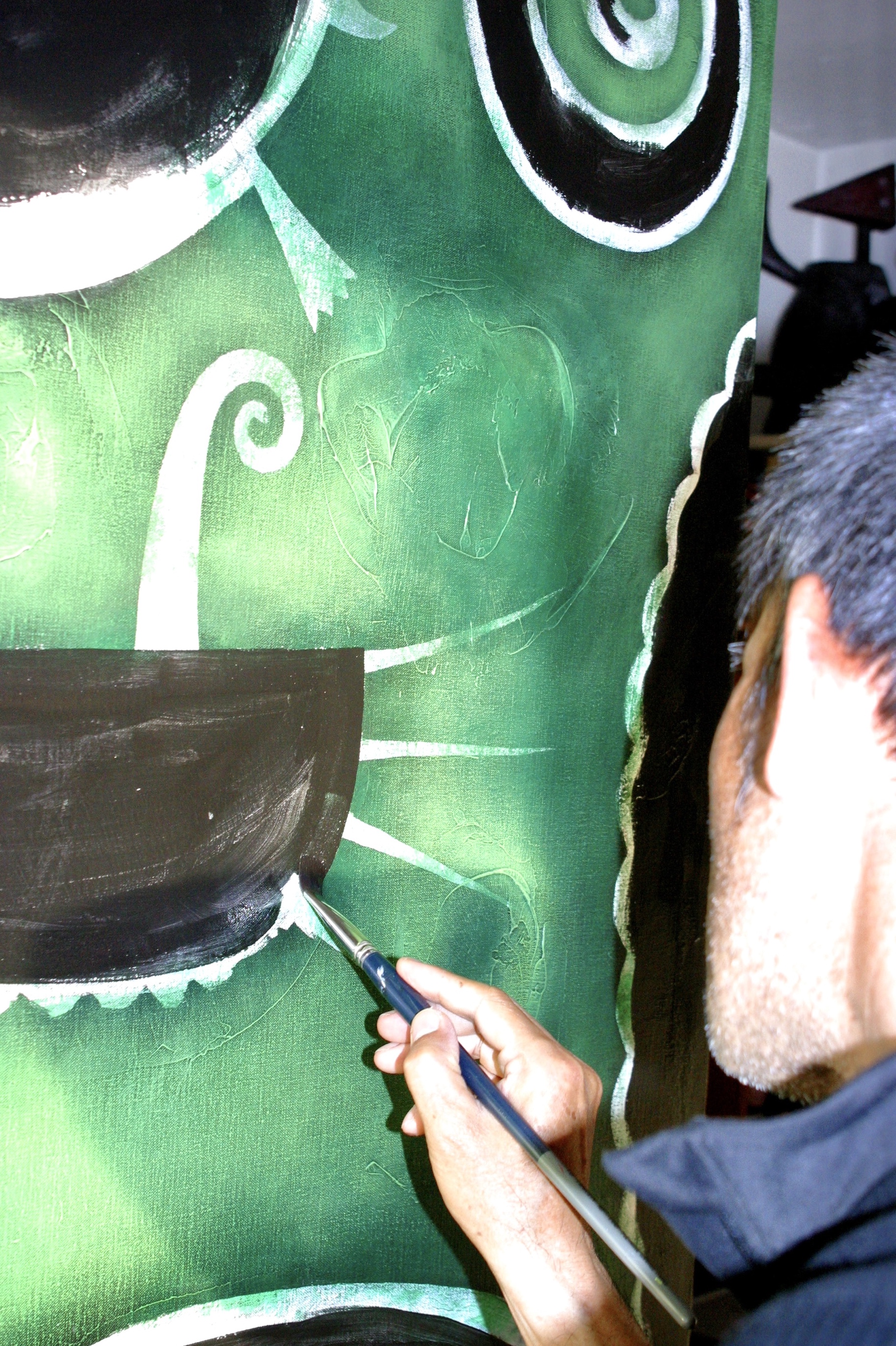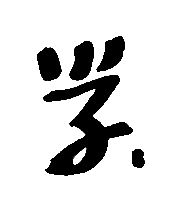
Manabu Kochi is a Japanese Contemporary artist who was born in Okinawa in 1954. He studied at the Tokyo Zokei Art University, the Musashino Art University in Tokyo and further pursued his studies in Florence, Italy (1979-1981) at the Accademia di Belle Arti di Firenze. Shaping his style in Tokyo, Florence and London, Kochi lives and works in Paris, France since 1981 in a close link with the Claude Lemand Gallery.
Since his first solo exhibition in 1989, Kochi’s work has been exhibited internationally in both solo and group exhibitions. His work was selected by the National Academy of
Recording Arts and Sciences (NARAS) to be the 1996 Official Grammy® Artist and the official artist for the MusiCares® for the 1996 New York ArtExpo as well as exhibiting within the prestigious halls of the Grand Palais, Paris. Numerous key galleries and museums such as Galerie Claude Lemand have featured Manabu Kochi's work in the past. His works have been offered at auction multiple times in Christie’s, Sotheby’s or Bonhams.
Collections
Institut du Monde Arabe, Paris, France.
Bibliothèque Nationale de France (BNF), Cabinet des Estampes, Paris, France.
Bibliothèque Nationale de Paris, France
Novotel contemporary art collection, France.
Musée de plain air, Golf de l’Amirauté, Deauville, France.
Benoît-de-Puydt museum, Bailleul, France.
Musée de
l’Hospice Saint-Roch Issoudun, France.
Collection Claude et France Lemand, France.
Naha Cultural Arts Theater NAHArt, Japan.
Oita city museum, Japan.
Okinawa Contemporary Art museum, Japan.
Art Okinawa University Library, Japan.
Sakima Art museum, Japan.
EM, Okinawa, Japan.
Palm Royal Hotel, Japan.
Palm Hills Resort, Okinawa, Japan.
Star Art Foundation, USA.
National Academy of Recording Art &
Sciences, Inc , USA.
Politeo collection, Croatia.
Fundación Museo del Grabado Español Contemporáneo, Marbella, Spain.
Artpieces Auctioned at
Christie’s
Sotheby's
Bonhams
Artcurial
Art Critic
“Working in the fields of sculpture, painting and engraving, Kochi has succeeded in creating a personal link between Primitive Arts and the most innovative movements in European Modern Art. His works are full of philosophy, humour, colour and harmony.”
Written by Claude Lemand, Paris.
“The way Manabu Kochi forms shapes in his painting can be basically defined as “metamorphic”. For instance, a human figure turns itself into an animal or plant figure, the other way around, sometimes a combination of both. He transforms existing, concrete figures into freely open forms. His painting is based on ancient and modern transformation myths, which reflect the way shapes in our lived reality must endlessly transform. It is the “light” that enables this eternal metamorphosis. Light, like the maternal oceanic, gives life varied forms and allow them to live within its realm. While these forms, in the richness of light, continue to metamorphose forever…”
Written by Hideo Yamamoto,
Tokyo.
“Manabu Kochi’s spirited, witty art, ranging over the enormous variety of styles with cosmopolitan ease, is clearly postmodernist. [...]His figures are bizarre hybrids of incongruous human and natural parts, ironically yet lovingly reconciled in a wa reminiscent of Miro and Klee, and his tondos are literally globes, cosmic landscapes, every part of which is equally valid. Kochi’s images on the small slate blackboards children us to draw on are particularly delightful marvels of his playfulness. Like all of his works, they are rich with references to art history and popular culture, given an ironic twist as well as tender loving care...”
Written by Françoise Monnin, The Revelation of Energy,
Claude Lemand Gallery, Paris.
“Like all Kochi’s hybrid individuals, it is a simultaneously living
being and a weird object, part crystalline geometry, part organic
matter. What seems particularly important about them is that
they integrate two orders of knowledge: intimate “acquaintance
knowledge” and abstract “about knowledge,” as William James
calls them. They are typically opposed, but Kochi makes them
complementary. That is, he creates a double perspective on his
individual, extending the ‘simultaneity’ that began in Cubism:
a personal, close up, concrete, colourfully experience of it
and a detached universal view of it, that is, a “survey” and
“conceptualization” of it from a distance overhead. It is as though
we are simultaneously seduced by the individual and looking at a
map of it. For that is ultimately what Kochi shows us: familiar
forms emerging from and dissolving back into a cosmic forcefield, signalled by dynamic allows and swirling forms he often
uses. The material objects are transient appearances in a field of
eternal energy, which is Koch’s true theme. It manifests itself in
material fragments, and is always on the move. Kochi ecstatically
swims in it. He achieves the proverbial oceanic experience, but
he does not want to lose control completely - be carried along
blindly by its current – which is why his figures, for all their fluid
and fragmentary character, are rigorously conceived”.
Written by Donald
Kuspit, Manabu Kochi - Postmodernist Dreamer,
New York.
Publications List
[Coming soon]
Collections
Institut du Monde Arabe, Paris, France.
Bibliothèque Nationale de France (BNF), Cabinet des Estampes, Paris, France.
Bibliothèque Nationale de Paris, France
Novotel contemporary art collection, France.
Musée de plain air, Golf de l’Amirauté, Deauville, France.
Benoît-de-Puydt museum, Bailleul, France.
Musée de l’Hospice Saint-Roch Issoudun, France.
Collection Claude et France Lemand, France.
Naha Cultural Arts Theater NAHArt, Japan.
Oita city museum, Japan.
Okinawa Contemporary Art museum, Japan.
Art Okinawa University Library, Japan.
Sakima Art museum, Japan.
EM, Okinawa, Japan.
Palm Royal Hotel, Japan.
Palm Hills Resort, Okinawa, Japan.
Star Art Foundation, USA.
National Academy of Recording Art & Sciences, Inc , USA.
Politeo collection, Croatia.
Fundación Museo del Grabado Español Contemporáneo, Marbella, Spain.
Artpieces Auctioned at
Christie’s
Sotheby's
Bonhams
Artcurial
Art Critic
“Working in the fields of sculpture, painting and engraving, Kochi has succeeded in creating a personal link between Primitive Arts and the most innovative movements in European Modern Art. His works are full of philosophy, humour, colour and harmony.”
Written by Claude Lemand, Paris.
“The way Manabu Kochi forms shapes in his painting can be basically defined as “metamorphic”. For instance, a human figure turns itself into an animal or plant figure, the other way around, sometimes a combination of both. He transforms existing, concrete figures into freely open forms. His painting is based on ancient and modern transformation myths, which reflect the way shapes in our lived reality must endlessly transform. It is the “light” that enables this eternal metamorphosis. Light, like the maternal oceanic, gives life varied forms and allow them to live within its realm. While these forms, in the richness of light, continue to metamorphose forever…”
Written by Hideo Yamamoto, Tokyo.
“Manabu Kochi’s spirited, witty art, ranging over the enormous variety of styles with cosmopolitan ease, is clearly postmodernist. [...]His figures are bizarre hybrids of incongruous human and natural parts, ironically yet lovingly reconciled in a wa reminiscent of Miro and Klee, and his tondos are literally globes, cosmic landscapes, every part of which is equally valid. Kochi’s images on the small slate blackboards children us to draw on are particularly delightful marvels of his playfulness. Like all of his works, they are rich with references to art history and popular culture, given an ironic twist as well as tender loving care...”
Written by Françoise Monnin, The Revelation of Energy, Claude Lemand Gallery, Paris.
“Like all Kochi’s hybrid individuals, it is a simultaneously living being and a weird object, part crystalline geometry, part organic matter. What seems particularly important about them is that they integrate two orders of knowledge: intimate “acquaintance knowledge” and abstract “about knowledge,” as William James calls them. They are typically opposed, but Kochi makes them complementary. That is, he creates a double perspective on his individual, extending the ‘simultaneity’ that began in Cubism: a personal, close up, concrete, colourfully experience of it and a detached universal view of it, that is, a “survey” and “conceptualization” of it from a distance overhead. It is as though we are simultaneously seduced by the individual and looking at a map of it. For that is ultimately what Kochi shows us: familiar forms emerging from and dissolving back into a cosmic forcefield, signalled by dynamic allows and swirling forms he often uses. The material objects are transient appearances in a field of eternal energy, which is Koch’s true theme. It manifests itself in material fragments, and is always on the move. Kochi ecstatically swims in it. He achieves the proverbial oceanic experience, but he does not want to lose control completely - be carried along blindly by its current – which is why his figures, for all their fluid and fragmentary character, are rigorously conceived”.
Written by Donald Kuspit, Manabu Kochi - Postmodernist Dreamer, New York.
Publications List
[Coming soon]
It can be said that my Expression is a kind of manifestation of Energy;
this is generated by Harmony of changing Diversities. This Energy
including both spiritual and material meanings can be generated when
any kind of form and colour completes the Harmony. This Harmony, I
mean, is that the original individuality of each form and colour can coexist with other Diversities, but at the
same time can emphasize more its
original individuality. It is because of the existence of the Diversities that
its original individuality can be flourishing further. For example, in the
world where there is only blue colour, the identity of the blue can
not exist.
We can recognize the blue colour simply because
of the existence of other colours and by composing with
other colours. We can make the blue to be more
flourishingly blue. Therefore, one colour is not the
absolute and lonely existence, and its identity can
be formed by co-existence of the Diversities. Any
colour, any form, without limitation, I am trying
to catch them on their ever changing aspects which can be seen at moment
to moment, breathing together, to form them to my expression. Since these
changing Diversities would provoke my spirituality, I can always create new
and unique art of my own. I believe that this might be the reason of the
freshness of my expression. And since my expression is the manifestation of
energy, it could have a continuous and stable universality. This is the base of
my art. This manifestation of Energy and the Harmony of ever changing
Diversities, both should be unified and should be on the same level in my art.

